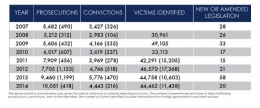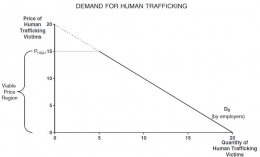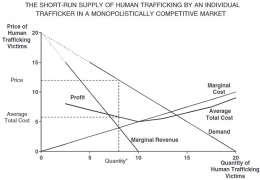One of the direct impacts of human trafficking is the minimal and no receipts received by migrant victims. No income means no remittances from migrants to the country of origin. Legal transfers of funds by migrants, including individuals, businesses, and other non-market sources, have evolved and represented international capital flows. The Committee on Payment and Settlement Systems and the World Bank, in a publication related to the general principles of international payments, explained that in 2007, the international flow of payments from foreign workers was 232 billion USD, with developing countries receiving 160 billion USD, while the remaining 50% was informal and domestic. Remittances have the most significant positive impact on women, children, and the elderly (UNODC, 2008). The direct effects of human trafficking then eliminate the benefits that these groups should receive.
The Human Trafficking Market
Markets in economics are defined by Wheaton et al. (2009) as a place (physical or virtual) that connects buyers "demand" and sellers "supply" either directly or indirectly. The hallmark of the market for human trafficking is the existence of intermediaries who connect supply and demand. In Wheaton's model, the market consists of several participants who shape the dynamics of the market through the decisions of all individuals. Markets are shaped by: labor supply decisions determined by vulnerable populations; labor demand decisions by employers; and intermediation decisions by traffickers.
In contrast to Wheaton, Besci (1999), in "Economics and Crime in the State" builds an economic model by taking into account the direct or indirect role of the government. The actors in the model include criminals, non-criminal actors (at household and private levels), and government. Government influences supply and demand, directly on the demand side and indirectly on the supply side. According to Kyle and Dale (2001), the government's role and acts of corruption are often the main discussions in the criminal enforcement literature. However, factors such as cultural norms, corruption, and household time allocation of each individual in the family are difficult to include in the economic model (Wheaton et al., 2009).
The assumption used in the market is the rational-choice theory which assumes that individuals will use all available information and compare cost-benefit to obtain the highest level of profit. In addition to using several assumptions that will be explained in the next section, the economic model also contains several shortcomings, especially in the case of human trafficking. The economic model simplifies reality and excludes several variables, so it cannot perfectly reflect the complexity of the human trafficking market.
The human trafficking market is described by Wheaton (2009) in the form of a monopolistic market. The market consists of many sellers (traffickers) who offer differentiated products (vulnerable individuals) for sale to many buyers (employers). There are several reasons why the human trafficking market is monopolistic. First, human trafficking is carried out by organized criminal groups or by networks of small entrepreneurs (Kwong, 1997). Lower barriers for sellers to enter and exit the market provide more incentive for potential sellers to enter the market. Second, buyers exploit vulnerable individuals for various forms such as exploitation of workers, forced marriage, sexual exploitation, illegal organ trafficking, and others. Third, products are differentiated goods with personal attributes that have been attached to individuals. The negotiation process between traffickers and employers is based on price, which gives more control for traffickers to determine the price level (Wheaton, 2009).
Demand













